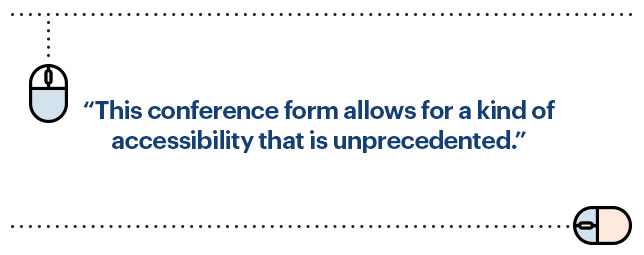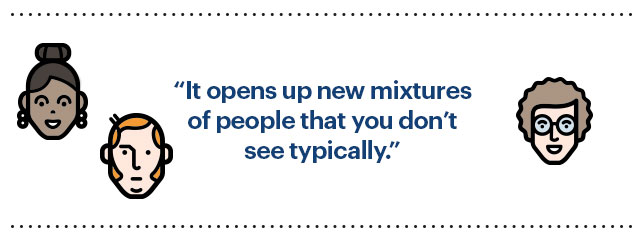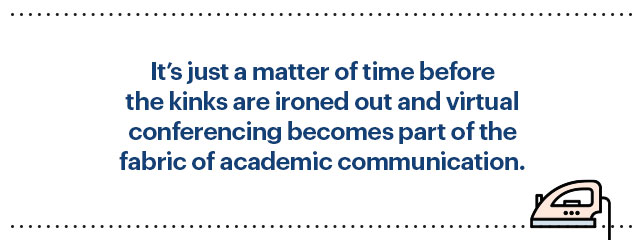Earlier this year, Orad Reshef was trying to pull his life back together after being away from his Ottawa home for 10 of the previous 14 days. First there was a conference in San Francisco. Getting home from that left him with a pocketful of reissued boarding passes thanks to delays and cancellations (this was before the COVID-19 pandemic essentially shut down all international travel). Two days later, a rail blockade nixed a planned train trip to Kingston, Ontario, for work. He was forced to drive, still getting over his jet lag, and dialled his parents on the way home so they could help him stay awake.
Be it viral outbreaks, visa challenges, bad weather or simply the time involved, work-related travel has a lot of knocks against it these days. But there was little to no travel required for the first online photonics conference that Dr. Reshef, a postdoctoral fellow in nanophotonics and nonlinear optics at the University of Ottawa, helped to organize this past January. Inspired by a Twitter exchange last September about an article on the carbon-emissions impact of academic conferences, Dr. Reshef, Andrea Armani of the University of Southern California and others pulled the experiment together in little more than four months.
“I thought, ‘Whatever. I’ll do it and if there’s 50 people on the stream, that’s great,’” said Dr. Reshef over Skype from a U of O office in mid-February. On January 13, the day of the conference, more than 1,000 people participated in the free #POM20 (for Photonics Online Meet-up) from across the globe, more than half via in-person “hubs” set up across six continents. There, participants could congregate to watch the five-hour-long event and its 12 livestreamed presentations on aspects of the science and technology of light. University of Cambridge physicist Mete Atature’s invited talk on quantum optics with new materials was videobombed by his white and ginger cat, to viewers’ delight.
“It was beyond our wildest expectations,” said Dr. Reshef. “We had hubs in South Africa, in China, in India. Some hubs were up in the middle of the night. … The time zone wasn’t suited for them, but they didn’t care.”

The environmental impetus
The event was just one small manifestation of the growing interest among scholars to experiment with alternatives to traditional academic conferences, leveraging online and digital technologies that allow participants to stay physically closer to home. The shuddering impact of the global COVID-19 pandemic may hasten this trend to virtual conferences, but the initial impetus was environmental – the desire to reduce carbon emissions caused by flying.
A 2018 study by the Pacific Institute for Climate Solutions estimated that the greenhouse gas emissions from business-related air travel each year at the University of British Columbia was equivalent to two-thirds of the annual emissions from campus operations, or 26,000 to 32,000 tonnes of carbon dioxide. To put that in perspective, UBC’s department of geography, which recently switched to a more efficient heating system, had emissions 30 times lower than those from the university’s business-related air travel.
A recent survey of Université de Montréal estimated that academic travel accounted for 30 percent of its total CO2 output. Professors, the survey found, travel more than 33,000 km per person per year.
“We definitely need to change our behaviours, so if scientists cannot do it, who’s going to?” said Sébastien Caquard, an associate professor at Concordia University’s geography, planning and environment department. (Dr. Caquard, like others, was interviewed before the full force of the COVID-19 pandemic had hit.) His department committed to reducing its air travel through a “flying less policy,” released last summer.
Other concerns
But other, non-environmental concerns about traditional in-person conferences have cropped up, too. Some complain that the model of people reading papers their audience can read themselves has dulled academic exchange and needs a shakeup. There is also the inequity of holding large international gatherings that privilege those with access to funding to cover expensive travel costs and registration fees while leaving scholars with fewer resources out of the conversation – be they graduate students, sessional instructors or those in the global south. Scholars with family caregiving responsibilities can also be left out.
In late April 2018, then postdoctoral fellow Jean Polfus was part of a virtual panel discussion on sustainable research in Canada’s north along with Amy Amos of the Gwich’in Renewable Resources Board, based in Inuvik. The panel was part of the livestreamed Around the World Conference, the fifth in a series organized by the University of Alberta’s Kule Institute for Advanced Study since 2013. Organizers billed the series as “an experiment that brings together a research dialogue without the environmental cost of traditional conferences.”
It’s unlikely that Dr. Polfus would have participated in the conference if it hadn’t been online, she said. At the time, she was based in Tulita, Northwest Territories, a community of about 500 that was a $1,600 return-airfare ticket away from Yellowknife, the closest travel hub. A full ticket to Edmonton would have run more than $2,000.
“Travel is extremely prohibitive from those very small, remote communities, so remote conferences could be helpful to allow participation from community members when we don’t always have enough funding to bring people down south,” said Dr. Polfus, who has moved on to become a senior biologist with the Canadian Wildlife Service, in Kelowna, B.C.

Andrea Muehlebach is an anthropology professor at the University of Toronto Mississauga and one of a handful of organizers of Distribute, the biennial conference of the Society for Cultural Anthropology and Society for Visual Anthropology. Scheduled for May 7 to 9, organizers plan to go ahead despite the pandemic, helped by the fact that Distribute, similar to #POM20, was already going to be livestreamed via a website. It builds on the two societies’ inaugural virtual conference in April 2018, called Displacements, which drew more than 1,200 participants from 40 countries, and more than 100 presentations. Previous SCA conferences had typically attracted about 250 participants. Individuals paid either $10 each to participate, or $100 per institution.
“This conference form allows for a kind of accessibility that is unprecedented,” said Dr. Muehlebach earlier this year. “People are playing with the format and running with it.”
The original plan was to disperse this year’s conference across multiple global group-viewing “nodes” hosting additional in-person activities, similar to last year. Given that the pandemic has made most in-person meetings impossible, organizers are working to integrate more interactive features into the virtual conference, such as a “virtual conference hallway” for conference participants, virtual coffee hours that faculty host for graduate students or younger colleagues, and virtual meet-ups that university presses have agreed to hold for scholars seeking publication venues.
Remote options to in-person conferences
Even large traditional conferences have shown a growing interest in offering virtual-participation options. The idea “is definitely coming up a lot more,” said Leslie Pelch, an event planner with the Vermont-based Delaney Meeting and Event Management. She has been working with the International Association of Landscape Ecologists North America to help organize its annual meeting at the University of Toronto from May 10 to 14.
Spurred by last fall’s global climate protests, the conference had planned this year to experiment with a remote-participation option for a self-selecting group of participants and presenters from far-flung places like Pakistan, Japan and Brazil. The idea was to livestream the conference’s three plenaries and offer one session of virtual presentations to registered remote participants.
Of course, those plans have been jettisoned due to the pandemic, and the conference will now be moving fully online. According to the conference website, plenary sessions will occur via the virtual-meeting platform Zoom and poster presenters will use a platform called iPosterSessions. Details on how some of the other aspects of the conference will be delivered, such as workshops and networking opportunities, are still being worked out.
Despite today’s technology, moving away from the traditional conference model is not straightforward and requires overcoming a variety of barriers which can get higher the larger the gathering. Finances is a big one. Most scholarly societies rely on conference revenue to support their activities the rest of the year and there’s worry that remote participants won’t expect to pony up a full fee if they’re not physically using onsite facilities.
In addition, planners who want a virtual add-on to a traditional conference can face extra costs for the hardware, software and support required. Contracts with hotels and conference centres may be predicated on a minimum number of attendees staying overnight, with some meeting space and/or services supplied for free or at a discount. “If now half of the people aren’t coming, we have to pay for the meeting room,” said event planner Ms. Pelch. “In some ways, it’s become more expensive.”
Technology’s great – when it works
Today’s communications technologies are impressive, but they change rapidly. As well, anyone who’s had to make one piece of technology play nicely with another knows things can fail, sometimes spectacularly, as Ryan Katz-Rosene and his colleagues found when they held a hybrid conference of the Environmental Studies Association of Canada at last year’s Congress of the Humanities and Social Sciences in Vancouver. ESAC hooked up a satellite conference for about 10 scholars from Memorial University’s Grenfell campus in Corner Brook, Newfoundland, allowing for virtual presentations and online viewing.
“We were too ambitious,” recalled Dr. Katz-Rosene, an assistant professor at the University of Ottawa’s school of political studies and co-editor of the online Flying Less in Academia Resource Guide (recently updated to guide scholars in how to participate digitally in different virtual conferences during the pandemic). One session had two presenters in Vancouver and two in Corner Brook. The technical assistant got everything set up fine, but problems cropped up after that person left and the event was underway.
There was tinny and delayed sound coming in from Corner Brook – good-quality audio and microphones have been flagged as a top consideration for anyone attempting virtual conferencing. When presenters shared slides, viewers couldn’t see their faces. Moderators scrambled to trouble-shoot during the presentation. “It was a bit of a nightmare,” said Dr. Katz-Rosene.
There can also be logistical challenges around coordinating between time zones and maintaining uniform start, stop and break times. It’s also important to ensure that a hosting venue has sufficient internet bandwidth and speed to support what you want to do, not to mention a secure system. The 2016 Congress found itself in the midst of a cyberattack when the University of Calgary’s IT system was targeted by extortionists. The university’s email, wireless servers and other systems were disabled, although Congress was still able to run as planned.

Collaboration and contacts
And that all-important part of the academic conference – the informal hallway and social chats that can spark new ideas, fresh collaborations and valuable contacts, especially for early career researchers – remains a struggle for virtual conferences to replicate.
That hasn’t stopped people from searching for ways around that, too. The volunteer-run Virtually Connecting organization uses onsite “buddies” and Zoom to bring a maximum of 10 offsite individuals into those all-important breaktime conversations with presenters and/or a group of onsite participants at academic conferences, often setting them up explicitly for that purpose.
“We can have these low-barrier conversations and invite people to come in and just chat, talk or meet somebody,” said Helen DeWaard, one of several VC co-directors who is also a sessional education instructor at Lakehead University. The free service, designed primarily to improve conference access, has about 80 volunteers, mostly in the educational technology space, and its YouTube channel has several hundred archived videos from the chats they’ve facilitated over the last four years.
A conference of music cognition specialists used a variation of this concept at its weeklong “semi-virtual” conference in July 2018. The ICMPC15/ESCOM10 (International Conference on Music Perception and Cognition/European Society for the Cognitive Sciences of Music) triennial set up zones near breaktime areas so that participants at its four global hubs – in Montreal; La Plata, Argentina; Graz, Switzerland and Sydney, Australia – could connect informally with each other as well as with presenters. Attendees could use their own devices or video interfaces that were provided. Feedback was mixed, but organizers pointed out that what was lost in face-to-face interactions was gained in a 50-percent increase in attendance, to 800 attendees, many of whom would otherwise have not been part of the conference at all.
“It opens up new mixtures of people that you don’t see typically,” said Eldad Tsabary, an associate professor of music and coordinator of electroacoustic studies at Concordia University, who was one of the two lead organizers for the Montreal hub. That, he added, allows “more epistemologies to mix together, more ways of knowing, more ways of thinking.”
Just a matter of time
It’s still early days for these virtual alternatives, and while it’s unclear how much disruption they might cause to traditional models, enthusiasts say it’s just a matter of time before the kinks are ironed out and virtual conferencing becomes part of the fabric of academic communication.
It’s taken a few years for Gabriel Miller, president and CEO of the Federation for the Humanities and Social Sciences, but he’s moved from being a skeptic to being more excited about the possibilities for using virtual technology to improve access, affordability and environmental sustainability at Congress. “I think the culture shift here is everyone understanding that part of our job is to be plugged into technology – and that’s a huge shift,” he said.
It’s a moot point now, as this year’s event – which was scheduled to take place at Western University in London, Ontario, from May 30 to June 5 – was cancelled in mid-March due to the ongoing pandemic. The Federation had initially proposed moving Congress online, but reversed course and announced on April 2 that the event would not happen in any form this year. “It is time to pause and give ourselves some space to meet our immediate needs,” Mr. Miller said in a videotaped message.
A change in the cultural norm of flying to a far-off conference and delivering a paper as part of one’s career advancement won’t happen overnight, but change is inevitable. “If we were to let go of conferences as they are, they would be missed by a lot of people – but not by everyone, and not equally,” said Anne Pasek, a postdoctoral fellow in energy transitions and a coordinator for U of A’s Energy In/Out of Place virtual conference being held May 19 to 22, part of the Kule Institute’s Around the World virtual conference series. “As with all new technologies, new media forms and the adaptation of old ones, [there’s] the question of affordances and trade-offs – but also of invention, and of trying to build a more interesting and equitable forum for exchange.”
The current pandemic will no doubt accelerate the process. “This is going to be an interesting test of the system,” said the Canadian Wildlife Service’s Dr. Polfus. “It will be like a forced experiment, and does this work?”
Organizers of virtual conferencing are often eager to share what they’ve learned. Here’s a list of resources and guides for thinking about and planning different kinds of virtual conferences:
- A Nearly Carbon-Neutral Conference Model, a guide put together by Ken Hiltner at the University of California, Santa Barbara, which has produced six “nearly carbon-neutral” conferences since 2016
- Moving Ideas without Moving People, an e-conferencing toolkit by the Kule Institute for Advanced Study at the University of Alberta
- Semi-Virtual Conference Guidelines, written by Richard Parncutt and Nils Meyer-Kahlen, following the ICMPC15/ESCOM10 four-hub conference in July 2018
- Reflections on #displace18, a post-mortem on the SCA/SVA’s 2018 Displacements conference, by Anand Pandian
- How to organize an online conference, by the organizers of the Photonics Online Meetup in January 2016
